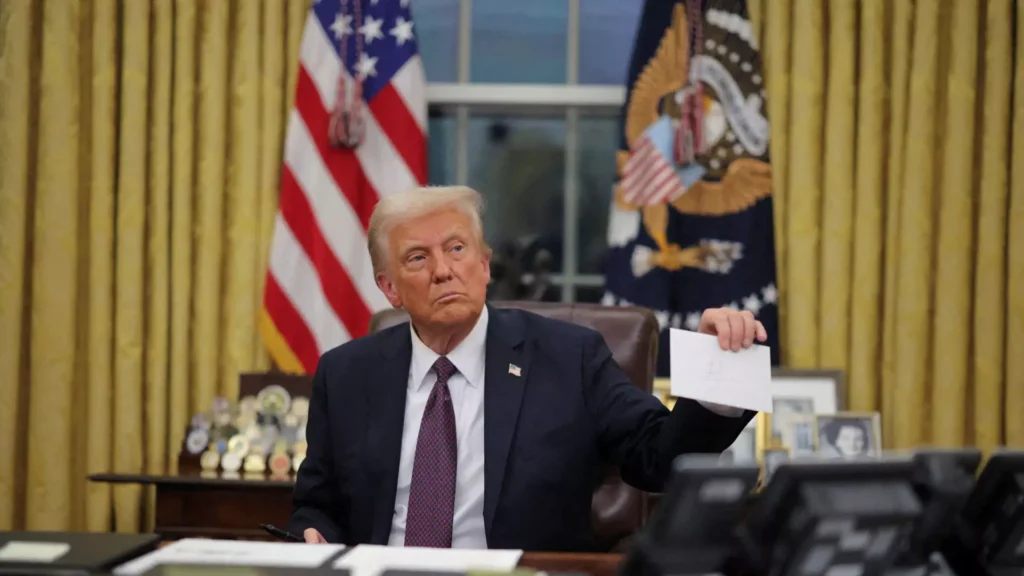U. S. President Donald Trump has disclosed his contentious exchanges with the King of Jordan Abdullah II regarding the possibility of transferring more than a million Palestinians from Gaza to neighboring countries. This very novel concept reveals Trump unusual stance on the long-standing Israeli-Palestinian conflict, in stark contrast with the conventional U.S. foreign policy.
Trump’s Conversations with Regional Leaders
During a recent phone conversation with King Abdullah II, Trump is reputed to have suggested that Jordan take in more Palestinian refugees. Speaking aboard Air Force One, he stated, “I said to him that I’d love you to take on more because I’m looking at the whole Gaza Strip right now, and it’s a mess, it’s a real mess. However, Jordan’s state news agency, Petra, did not confirm the mention of relocation during the call.
According to United Nations data, Jordan has been over 2.39 million Palestinian refugee registrations before. Trump also outlined plans to bring the resettlement problem to the attention of Egyptian President Abdel Fattah el-Sisi and to suggest that Egypt too might take in displaced Gazans. It’s a million and half people and we just scrub that off, “the president remarked, portraying the war in the Gaza Strip as a permanent, intractable tragedy.
Humanitarian Catastrophe in Gaza
The humanitarian situation in Gaza has reached crisis level in the context of current conflict between Israel and Hamas. According to the United Nations, Israeli airstrikes have destroyed or damaged 60% of Gaza’s infrastructure, including homes, schools, and hospitals. Destruction has rendered nearly all of Gaza’s population displaced, in some cases, having to move many times. Trump called Gaza “literally [a] demolition site” and offered the idea of moving its inhabitants to Arab states, where they could “finally live at peace,” [i.e].
Drawing on his background as a real estate developer, Trump proposed constructing housing for displaced Palestinians, possibly on either a temporary or permanent basis. His comments brought to light the logistical and political difficulties issues such a proposal would raise.
Regional and Global Reactions
Trump prescribes a sharp change from the historical US support for two-states solution. His vision is in line with positions accepted by certain extreme Israeli groups that support the eviction of Palestinians from Gaza and the West Bank to neighboring Arab countries–a policy that Israel’s government has explicitly and categorically ruled out.
King Abdullah II has firmly opposed such ideas. For example, in October 2023, he set the transfer of Palestinian refugees from Jordan or Egypt as a “red line” and the Egyptian president, mr. el-Sisi, also criticized the humanitarian displacement from northern Gaza of one million people by israel, stressing that such an evacuation may stop the people from feeling connected to the land. El-Sisi remarked, “The displacement or expulsion of Palestinians…simply means that a similar situation will also take place, emphasizing the importance of preserving the Palestinian identity within their homeland.
Historical Context
Globally, there are approximately 5.9 million Palestinian refugees, many of whom are descendants of those displaced during Israel’s establishment in 1948. Trump’s idea of moving homeland security is a considerable change from the approach of previous administrations.
Since his return to office, Trump has reversed several Biden-era policies, including re-imposing sanctions against Palestinian entities. He, moreover, granted the right of release of weapons held hitherto and under restraint, stressing the decisive steps taken in order to give concrete support to Israel’s defense requirements. “We released them today… They paid for them and they’ve been waiting for them for a long time, Trump stated.
Pro-Israel Hardliners in Trump’s Administration
Trump’s administration is composed of many pro-Israel people including new U.S. Ambassador to Israel, Mike Huckabee, who has explicitly rejected the possibility of an independent Palestinian state, as “absurd”. Other key members, such as National Security Advisor, Mike Waltz, and Secretary of State, Marco Rubio, opposed the ceasefire in Gaza and have sided with Israel’s annexation of the West Bank.
Future Outlook
In the event that the present strategy to defuse the Gaza problem is implemented, it is expected to reflect Prime Minister Benjamin Netanyahu of Israel’s views on the same situation, which may involve further military control and territorial annexation of Palestinian land. It is hypothesized that Trump’s position is an extension of 2020 peace proposal that legitimizes an Israeli annexation while burying the Palestinian claims.
Trump has also alluded to the redevelopment opportunity of Gaza, calling Gaza “one of the most gorgeous, desirable locations with the best waterfront real estate” (Runyon, 2018). Echoing his son-in-law Jared Kushner’s (JkS) remarks, Trump indicated that “making rash and hectic” of Gaza would open the way for new possibilities.
Conclusion
Trump’s proposal to move does not do anything less than reflect a radical change in the way the Trump administration dealt with the Israeli-Palestinian conflict. Although in line with the agenda of some of the Israeli groups it is highly opposed by regional officials and international watchers. The proposal also warrants a question concerning the practical possibility of mass evacuation and its potential consequences of Palestinian community identity and state.
“Stay updated with the latest news and insights – follow us at YPBB News on X for real-time updates and exclusive stories!”
